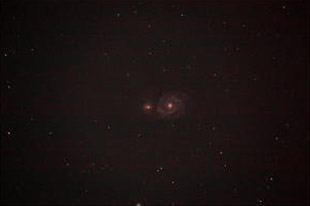Astrophotography - When Things Go Wrong - Excessive Thermal Noise

Excessive Thermal Noise
The following was retrieved from Wikipedia, the free encyclopedia, at
en.wikipedia.org/wiki/Image_noise
on February 28, 2016
Image noise
"Image noise is random (not present in the object imaged) variation of brightness or color information in images, and is usually an aspect of electronic noise. It can be produced by the sensor and circuitry of a scanner or digital camera. Image noise can also originate in film grain and in the unavoidable shot noise of an ideal photon detector. Image noise is an undesirable by-product of image capture that adds spurious and extraneous information.
The original meaning of "noise" was and remains "unwanted signal"; unwanted electrical fluctuations in signals received by AM radios caused audible acoustic noise ("static"). By analogy unwanted electrical fluctuations themselves came to be known as "noise". Image noise is, of course, inaudible.
The magnitude of image noise can range from almost imperceptible specks on a digital photograph taken in good light, to optical and radioastronomical images that are almost entirely noise, from which a small amount of information can be derived by sophisticated processing (a noise level that would be totally unacceptable in a photograph since it would be impossible to determine even what the subject was).
Types
In digital cameras
In low light, correct exposure requires the use of slow shutter speed (i.e. long exposure time), higher gain (ISO sensitivity), or both. On most cameras, slower shutter speeds lead to increased salt-and-pepper noise due to photodiode leakage currents. At the cost of a doubling of read noise variance (41% increase in read noise standard deviation), this salt-and-pepper noise can be mostly eliminated by dark frame subtraction. Banding noise, similar to shadow noise, can be introduced through brightening shadows or through color-balance processing.
The relative effect of both read noise and shot noise increase as the exposure is reduced, corresponding to increased ISO sensitivity, since fewer photons are counted (shot noise) and since more amplification of the signal is necessary.
Effects of sensor size
The size of the image sensor, or effective light collection area per pixel sensor, is the largest determinant of signal levels that determine signal-to-noise ratio and hence apparent noise levels, assuming the aperture area is proportional to sensor area, or that the f-number or focal-plane illuminance is held constant. That is, for a constant f-number, the sensitivity of an imager scales roughly with the sensor area, so larger sensors typically create lower noise images than smaller sensors. In the case of images bright enough to be in the shot noise limited regime, when the image is scaled to the same size on screen, or printed at the same size, the pixel count makes little difference to perceptible noise levels – the noise depends primarily on sensor area, not how this area is divided into pixels. For images at lower signal levels (higher ISO settings), where read noise (noise floor) is significant, more pixels within a given sensor area will make the image noisier if the per pixel read noise is the same.
For instance, the noise level produced by a Four Thirds sensor at ISO 800 is roughly equivalent to that produced by a full frame sensor (with roughly four times the area) at ISO 3200, and that produced by a 1/2.5" compact camera sensor (with roughly 1/16 the area) at ISO 100. This ability to produce acceptable images at higher sensitivities is a major factor driving the adoption of DSLR cameras, which tend to use larger sensors than compacts. An example shows a DSLR sensor at ISO 400 creating less noise than a point-and-shoot sensor at ISO 100.
Sensor fill factor
The image sensor has individual photosites to collect light from a given area. Not all areas of the sensor are used to collect light, due to other circuitry. A higher fill factor of a sensor causes more light to be collected, allowing for better ISO performance based on sensor size.
Sensor heat
Temperature can also have an effect on the amount of noise produced by an image sensor due to leakage. With this in mind, it is known that DSLRs will produce more noise during summer than winter.
Image noise reduction
An image is a picture, photograph or any other form of 2D representation of any scene. Most algorithms for converting image sensor data to an image, whether in-camera or on a computer, involve some form of noise reduction. There are many procedures for this, but all attempt to determine whether the actual differences in pixel values constitute noise or real photographic detail, and average out the former while attempting to preserve the latter. However, no algorithm can make this judgment perfectly, so there is often a tradeoff made between noise removal and preservation of fine, low-contrast detail that may have characteristics similar to noise. Many cameras have settings to control the aggressiveness of the in-camera noise reduction.
A simplified example of the impossibility of unambiguous noise reduction: an area of uniform red in an image might have a very small black part. If this is a single pixel, it is likely (but not certain) to be spurious and noise; if it covers a few pixels in an absolutely regular shape, it may be a defect in a group of pixels in the image-taking sensor (spurious and unwanted, but not strictly noise); if it is irregular, it may be more likely to be a true feature of the image. But a definitive answer is not available.
This decision can be assisted by knowing the characteristics of the source image and of human vision. Most noise reduction algorithms perform much more aggressive chroma noise reduction, since there is little important fine chroma detail that one risks losing. Furthermore, many people find luminance noise less objectionable to the eye, since its textured appearance mimics the appearance of film grain.
The high sensitivity image quality of a given camera (or RAW development workflow) may depend greatly on the quality of the algorithm used for noise reduction. Since noise levels increase as ISO sensitivity is increased, most camera manufacturers increase the noise reduction aggressiveness automatically at higher sensitivities. This leads to a breakdown of image quality at higher sensitivities in two ways: noise levels increase and fine detail is smoothed out by the more aggressive noise reduction.
In cases of extreme noise, such as astronomical images of very distant objects, it is not so much a matter of noise reduction as of extracting a little information buried in a lot of noise; techniques are different, seeking small regularities in massively random data.
Video noise
In video and television, noise refers to the random dot pattern that is superimposed on the picture as a result of electronic noise, the 'snow' that is seen with poor (analog) television reception or on VHS tapes. Interference and static are other forms of noise, in the sense that they are unwanted, though not random, which can affect radio and television signals.
Useful noise
High levels of noise are almost always undesirable, but there are cases when a certain amount of noise is useful, for example to prevent discretization artifacts (color banding or posterization). Some noise also increases acutance (apparent sharpness). Noise purposely added for such purposes is called dither; it improves the image perceptually, though it degrades the signal-to-noise ratio."
The license terms of this written work from Wikipedia may be found at http://creativecommons.org/licenses/by-sa/3.0/
Outreach || Flagstaff || Photos || Articles || Observing Sites || Weather
Coordinated Universal Time || National Weather Service
info@coconinoastro.org

